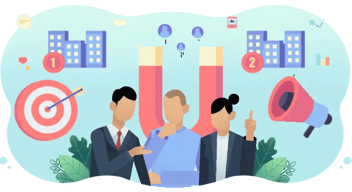How Visual Identity Fuels SaaS Marketing Success
SaaS founders obsess over features and functionality, but there's something they're missing that's quietly impacting their conversions. Your visual identity goes far beyond just a logo. It includes your UI screenshots, social media graphics, email designs, and every visual touchpoint customers encounter. Yet it's often treated as an afterthought, which is something to worry about "later" when the product is perfect.
Strong visual identity builds trust and improves recognition, which directly impacts conversion rates. When prospects can't distinguish your product from competitors, even the best features won't save you. Just think about it: Would you trust a banking app that looks like it was designed in 2010? Visual consistency is about creating instant recognition that cuts through the noise.
In this guide, you'll discover how visual consistency transforms marketing performance. You'll also get a practical checklist to audit your current visual identity and identify quick wins that drive real results.
What Is Visual Identity in SaaS?
Visual identity isn't just your logo copied and pasted across every piece of marketing material you create. It's the entire visual language that makes your brand recognizable, including all these elements:
-
Color scheme - The main and secondary colors that are seen everywhere
-
Typography choices - The fonts that make your content readable and recognizable
-
Illustration style - Whether you use photography, custom illustrations, or icons
-
Imagery approach - How you showcase your product through screenshots and demos
-
Visual elements - Buttons, borders, spacing, and layout consistency
All these elements need to work together across every touchpoint. This includes your website, product screenshots, social media ads, email campaigns, sales decks, and even your support documentation.
Why Visual Identity Matters More in SaaS Marketing
Here's the thing about SaaS. You are often selling to people who will never speak to a human on your team. No handshakes, no in-person demos, no relationship building over coffee. All the hard work must be done by your images. So, let's see why visual identity is important:
A. Trust-Building Without the Human Touch
In traditional sales, you build trust through relationships. In SaaS, your visual identity is your first impression, credibility check, and only chance to communicate professionalism. When someone lands on your site at 2 am researching solutions, your visuals are building (or destroying) trust in real time.
B. Standing Out in a Sea of Sameness
Walk through any SaaS directory and you'll see the problem immediately. Everywhere, there are similar layouts and generic stock images. Visual distinction becomes your secret weapon for breaking through the clutter when every competitor seems the same. A recent finding revealed that consumers believe only 5% of brands are truly unique. This highlights a massive challenge for SaaS companies; if most brands are perceived as interchangeable, how can you expect to capture and retain attention?
C. Shaping Product Perception
Your visuals literally program how people think about your software before using it. When it is good with modern design, it suggests your product is valuable. Outdated visuals scream "legacy software." Bold colors communicate innovation, while muted tones suggest enterprise reliability. You're not just showing your product, but you're defining it.
D. The Consistency Problem
Most SaaS companies nail their product UI but completely lose marketing consistency. Your landing page looks nothing like your product screenshots, which look nothing like your email campaigns. This disconnect creates friction at every step of the customer journey.
Consider the sheer volume: there are over 9,000 SaaS companies in the US alone, and the global SaaS market is valued at $390 billion. With such intense competition, standing out isn't just a nice-to-have; it's a necessity. Many SaaS brands, unfortunately, sound and look the same—similar color schemes, messaging, stock photos, and vectors across platforms. When prospects are bombarded with options that visually blend, it creates a significant barrier to recognition and recall. Your unique visual identity cuts through that noise, giving your brand a distinct and memorable presence.
7 Ways Visual Identity Drives SaaS Marketing Success
 1. Instant Brand Recognition
1. Instant Brand Recognition
Think about Slack's Distinctive color palette or Notion's clean, minimal aesthetic. You can spot them instantly in any context. Clear, consistent visuals create mental shortcuts that help people remember and revisit your product without effort.
When your visual identity is memorable, prospects don't have to dig through their browser history or saved emails to find you again. They just know. This recognition factor becomes incredibly valuable in long sales cycles where prospects might research for months before making a decision.
2. Higher Conversion Rates on Landing Pages
Generic stock photos and inconsistent UI screenshots impact conversions faster than slow loading times. When your landing page visuals authentically represent your actual product experience, visitors trust what they're seeing.
Additionally, custom imagery that aligns with your product's interface removes the guesswork and reduces friction. Prospects can instantly visualize themselves using your software, dramatically shortening the mental leap from "maybe" to "yes, I'll try this." Consistency between marketing promises and product reality builds the confidence needed to convert.
3. Stronger Ad Performance
Social feeds and ad networks are visual battlegrounds where attention spans last milliseconds. Your brand will stand out from the endless scroll when it is coherent, unique images. Also, when your ads maintain consistent visual language across platforms, you build recognition even if someone doesn't click immediately.
They've seen your brand before, which creates familiarity that improves performance on subsequent exposures. Generic visuals get ignored, but memorable ones get remembered and eventually clicked when the timing is right.
4. Increased Email Engagement
The layout of your email might either help establish your brand or leave readers unsure about who is sending it. When emails include real, brand-aligned graphics, they are instantly recognizable, which increases open rates before the reader even sees the subject line.
When your email template matches your product's visual language, subscribers perceive that they are continuing a conversation rather than starting from scratch with a stranger. This consistency helps build trust that translates into better click-through rates and stronger engagement throughout your entire email sequence.
5. Improved User Trust and Credibility
Custom visuals signal that you've invested in quality across every aspect of your business. When prospects see thoughtful, professional design choices, they assume the same attention to detail extends to your product development and customer support.
Generic templates and stock imagery suggest shortcuts, which makes people question what other corners you might have cut. Professional visual identity creates a perception of an established, reliable business that prospects feel confident trusting with their important business needs.
6. Reduced Churn Through Consistent Experience
When your product interface matches the visual promises in your marketing, users feel confident that they made the right choice. This alignment between expectation and reality prevents the disconnect that often leads to early churn. Users who recognize your visual language throughout their journey, from the first ad to product onboarding, develop a stronger attachment to your brand.
They're not constantly readjusting their expectations or questioning their decision. Instead, they're experiencing the seamless progression they expected, which builds loyalty and reduces the likelihood of switching to competitors.
7. Better Investor and Media Perception
Investors and journalists make snap judgments about your company's maturity based on visual presentation. A polished, consistent visual identity signals operational sophistication and market readiness that goes far beyond aesthetics. It demonstrates attention to detail, brand discipline, and professional execution qualities that investors look for in scalable businesses.
Media outlets are more likely to feature companies that photograph well and maintain professional brand standards. Your visual identity becomes a shortcut for communicating credibility to stakeholders who matter most for your growth trajectory.
The Problem with Overused Images in SaaS
Walk through any SaaS website and you'll start seeing the same faces everywhere. That smiling woman pointing at a laptop? She's been the "happy customer" for at least fifty different companies. Most startups default to stock images because they're cheap and fast. But your brand becomes instantly forgettable. Prospects might literally confuse your homepage with a competitor they looked at yesterday.
Think about it from their perspective. They are researching solutions, opening multiple tabs, and suddenly see identical illustration styles across different companies. Their brain questions like "Wait, is this the same company?"
Therefore, you should remember that a prospect always remembers your marketing but attributes it to a competitor because you used the same visual elements. You're literally funding your competition's brand recall.
How to Audit Your Visual Identity
It's time for some uncomfortable truth-telling. Most SaaS founders think their visual identity is fine without ever objectively examining it. Let's fix that.
1. The Cross-Platform Reality Check
Open your website, then your latest email campaign, then your LinkedIn ads, then your product screenshots. Put them side by side and ask yourself whether a stranger immediately knows all these came from the same company?
Look for consistency in colors, fonts, image styles, and overall vibe. If your landing page feels like a completely different brand from your product interface, you've found your first problem. Your prospects are experiencing this disconnect in real-time, and it's costing you conversions.
2. The Uniqueness Test
Here's the part that might sting. Take your original images, illustrations, and key graphics and run them through a Reverse Image Search tool. You might discover that your unique visuals appear on dozens of other websites, including your direct competitors'.
Use Smart Tools AI's reverse image search tool to find where your images appear elsewhere. Your customers might already have seen them somewhere else, which means you're building zero brand recognition. This simple audit reveals exactly how much visual real estate you're surrendering to generic, forgettable imagery that does nothing to differentiate your brand.
Final Words
Visual identity isn't just about aesthetics; it's about building trust, enhancing recognition, and ultimately driving conversions in a crowded SaaS market. Stop treating it as an afterthought. Start with the audit, identify your biggest visual gaps, and begin creating a consistent experience that prospects actually remember. Your future customers are already judging your product by how it looks.
If you're ready to transform your SaaS brand's visual presence and supercharge your marketing, Aspiration Marketing is here to help. We specialize in crafting comprehensive strategies that integrate powerful branding, engaging content marketing, impactful social media presence, and effective overall digital marketing solutions. Let's work together to ensure your visual identity consistently drives your success.
Frequently Asked Questions (FAQs)
Q1. How much should I budget for visual identity?
Start with 5-10% of your marketing spend. You don't need to blow your budget, but don't go cheap either. Good visuals pay for themselves through higher conversion rates.
Q2. Can I use the same visuals for B2B and B2C?
Probably not. B2B buyers want professional, clean aesthetics. B2C audiences prefer more approachable, playful visuals. You'll likely need variations for each audience.
Q3. How often should I refresh my visual identity?
Don't change it just because you're bored. A strong identity should last 3-5 years minimum. Only refresh when it genuinely looks dated or you're expanding markets. Consistency builds recognition.
.
This content is also available in:
- German: Wie visuelle Identität den Erfolg von SaaS-Marketing fördert
- Spanish: Cómo la identidad visual impulsa el éxito del marketing de SaaS
- French: Comment l'identité visuelle favorise le succès du marketing SaaS
- Italian: Come l'identità visiva alimenta il successo del marketing SaaS
- Romanian: Cum contribuie identitatea vizuală la succesul marketingului SaaS
- Chinese: 视觉识别如何推动 SaaS 营销取得成功

Opinions expressed in this article are those of the guest author. Aspiration Marketing neither confirms nor disputes any of the conclusions presented.






.png?width=352&name=What%20Does%20it%20Mean%20to%20Have%20Branding%20Guidelines%20(1).png)


Leave a Comment